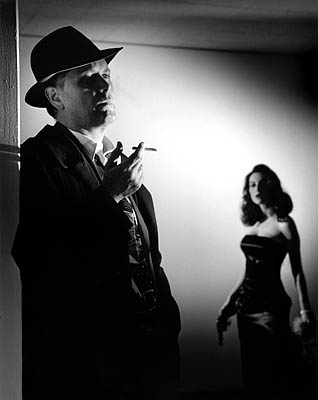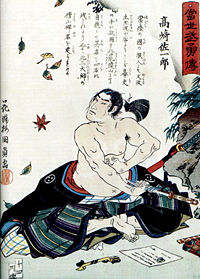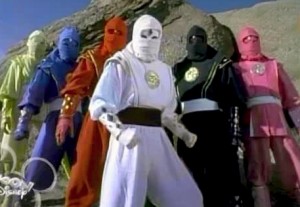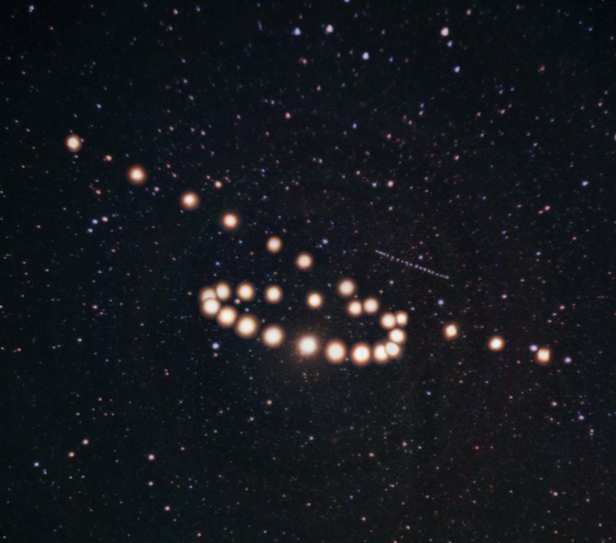The Harvest Queen and the River Dragon
August 21, 2012Dream Incubation
August 28, 2012by Guest Blogger Nick Civitello
Nick Civitello is a playwright and astrologer living in New York City. His blog, Nerdcore Astrotypes, details correlations between archetypes found in astrology to those found in pop-culture. Nick is currently the Vice President of the Association for Young Astrologers and has contributed writing to Night Sky Strategies and Rending The Veil. He also reads Tarot and enjoys all-you-can-drink karaoke.
Private Indeed
Mars archetypes are easy to write about, as their action-fueled nature makes them stand out. Long before Hollywood, producers of entertainment have been calling soldiers from the barracks and onto the stage or page in order to spice things up with some lovely discord. After all, the concept of “conflict” is integral to any progression of plot. If there was no point of contention, there would be no story.
 In the 1930’s and 40’s, writers, artists, and producers took particular notice of an underused, but unusually strong martial current. This character-type found itself cast in the starring role in many films of that era. Like most healthy Mars archetypes, they carried a sense of courage and daring in the face of adversity, a relentless drive to complete their mission, and a penchant for dispensing justice along the way. Unlike other Mars archetypes, however, their actions were motivated by an intense emotional focus, one that they would likely conceal for fear of a revealed weakness. Also of note was their willingness to face any pain or disgrace in the successful completion of their goal.
In the 1930’s and 40’s, writers, artists, and producers took particular notice of an underused, but unusually strong martial current. This character-type found itself cast in the starring role in many films of that era. Like most healthy Mars archetypes, they carried a sense of courage and daring in the face of adversity, a relentless drive to complete their mission, and a penchant for dispensing justice along the way. Unlike other Mars archetypes, however, their actions were motivated by an intense emotional focus, one that they would likely conceal for fear of a revealed weakness. Also of note was their willingness to face any pain or disgrace in the successful completion of their goal.
This is what you get when Mars is in Scorpio, its seat of dignity in the second half of the year. A water sign, on first glance, does not seem an ideal place to find Mars: its pro-active attitude works best when given a clear target, unobstructed by Water’s distortive quality. Water, also being associated with the soft and emotional, is also typically associated with characters that are thought of as mild and compassionate.
Scorpio surely can be these things, but is not typically thought of as such. Their hearts are worn far from their sleeves, held in the mud and sediment below a river’s torrent. Their surface actions indicate a shameless and unscrupulous individual, likely looked upon with disdain by polite society. Scorpio’s sustained mode mobilizes its Water into a force that will do whatever it must in order to get from one point to the next. Unlike other Mars archetypes who might smash through a boulder in one powerful go, Mars in Scorpio might avoid it by moving around it, going underneath it, or even by slow erosion of any obstructions. This translates into lying, cheating, stealing, scamming, manipulating, and most importantly, terrorizing people into lifting obstacles from Mars’ path.
When the Mars in Scorpio character is the leading man in a movie, we often call that “film noir,” and while they may be labeled as protagonists, you’d be hard-pressed to find those that would call these characters heroes. Rather, this genre of film popularized a hard-boiled version of the anti-hero in the gumshoe, the shadowy and crafty private eye. These characters were made popular in books by Raymond Chandler, Dashiell Hammett, and Mickey Spillane, to name just a few, and later became the backbone of what is now known as film noir. The genre itself serves as a journey across the rotten underbelly of day-to-day life, and who better to watch our backs than Mars in Scorpio?
It is also worth a chuckle that Scorpio rules the genitals, and these detectives are sometimes called “private dicks.”
“She was worth a stare. She was trouble.”
There’s something of a formula to these stories. The man in the middle of the mystery is not always an actual private detective, but always ends up trying to solve the thing anyway, so it’s likely more convenient to write the protagonist as a man with a professional interest. However, since the motivating factor is emotional, many of the best noirs don’t have a professional detective at their center.
Now, what is required is an emotional catalyst to jump start the proceedings. This usually comes in the form of a woman, the natural counterpart of the “private dick,” commonly referred to as a femme fatale. These dangerous but alluring women show up, ask for help, promise generous compensation, and leave the protagonist to do the dirty work. The first thing we can surmise is that she’s not telling the entire truth, and that she’s mixed up in something deadly. Whether or not she is actually a woman of ill-intent is another matter altogether, and a factor that changes from story to story.
In the case of films like The Big Sleep or Chinatown, our man does what he does because he’s fallen for the woman, and can’t help but follow her into Hell to try and rescue her…and turn a profit, if he’s able. The same could also be said for Casablanca, where Bogart’s character “Rick” realizes that the only way to protect the woman he loves is to send her far away from him and into the arms of another man.
In the 1944 classic, Double Indemnity, an insurance salesman (played by Fred McMurray) is approached by a housewife (played by Barbara Stanwyck,) who, after some flirtation, makes inquiries as to how she would be able to take out a policy on her husband without his knowledge. The two eventually begin a romance, plot his murder, and collect double the amount of the policy by making his death look accidental. The complications begin when they attempt to get away with the money and resume their affair. By the time our man realizes he’s been played for a fool, and that our femme fatale is now plotting his own demise, he’s too strongly coiled around the situation to disengage and walk away. The only thing left to do is to self-destruct, and take her along.
Sometimes, though, the femme fatale is simply a red herring, or an extra trapping which has little to do with the detective’s reasons. In The Maltese Falcon, for example, the events play out in a similar fashion to the previous synopsis: a woman approaches a detective with an assignment for him, asking him to track down a priceless artifact. In the ensuing investigation, Bogart’s partner is killed, and it is revealed that the woman is tangled up with some very unsavory characters who would like to find the artifact before she’s able. She, of course, still appears to be a well-meaning girl who’s found herself in a bad situation.
It is not until the film’s climax, when all of the bad guys have been killed, outsmarted, or arrested, and we think that Bogart and the broad can go start a new life together – it is not until then that Bogart tells the woman that he knows it was she that killed his partner, that her role in the plot was far greater than she let on, and that the police are on their way to arrest her, too. The motivation for Mars in Scorpio, in this instance, was based on justice and revenge, and was well-concealed by Bogart’s seeming indifference to his partner’s death.
In the 1990 film Miller’s Crossing, Tom Reagan is the top advisor to a mafia boss named Leo. The two have a long-standing friendship and a deep admiration for one another, but parts ways when they quarrel over the same woman. This comes at an inconvenient time, as other gangs in the area are becoming stronger, and Leo’s control is being buckled. Following their quarrel, Tom declares that he is through with Leo. He appears to join up with the rival gangs to oppose Leo, but what he is actually doing is manipulating them from the inside out, causing them to destroy one another and themselves. And yet, when all is said and done, and all the enemies are vanquished, he still leaves town, insisting that they are through. When Verna, the woman at the center of the disagreement, asks Tom why he’s done this, “I thought you said you don’t care about Leo no more.” He replies, “I said we’re through. That’s not the same thing.” His heart’s priorities wouldn’t allow him to walk away from a friendship while that friend was still in mortal danger.
The Planet That Wasn’t There
 In the last century, many astrologers have considered Scorpio to be one of three double-ruled signs, along with Aquarius and Pisces, in order to account for the three “outer planets” of our solar system that have been discovered more recently. The epiphanies of Uranus have come to be associated with the iconoclastic Aquarians, whereas Neptune’s realm of fantasy and horror is close to home for Pisces. Scorpio got the last little bundle of darkness, Pluto, named for the Roman God of Death and Hell. Its function is to destroy all that passes through until only its essence remains. Though its process is unbearably painful, its ability to mutate and transform can bring a person closer to who they really are and what they must truly do. The association with Scorpio, so willing to suffer and change if it meets its goal, is kind of a no-brainer.
In the last century, many astrologers have considered Scorpio to be one of three double-ruled signs, along with Aquarius and Pisces, in order to account for the three “outer planets” of our solar system that have been discovered more recently. The epiphanies of Uranus have come to be associated with the iconoclastic Aquarians, whereas Neptune’s realm of fantasy and horror is close to home for Pisces. Scorpio got the last little bundle of darkness, Pluto, named for the Roman God of Death and Hell. Its function is to destroy all that passes through until only its essence remains. Though its process is unbearably painful, its ability to mutate and transform can bring a person closer to who they really are and what they must truly do. The association with Scorpio, so willing to suffer and change if it meets its goal, is kind of a no-brainer.
Or at least, it would be if people still considered Pluto a planet. As it stands, Pluto has been demoted, and is now an “icy dwarf planet.” And while that doesn’t change its astrological function, some now question its status as a planetary ruler of Scorpio.
The jury’s still out for me; I’ve heard good arguments on either side. I bring this up not to stir up an argument, but to point out that the resonance between this sign and this planet is unmistakable, whether or not that resonance denotes rulership. For proof, we need only turn our attention back to this same genre of film – most particularly to its setting and its characters.
Firstly, it’s of some interest that Pluto, the God, had a special hat which allowed him to walk the Earth, invisible to the naked eye. Most noir protagonists can be found under the brim of a fedora,  behind a long trenchcoat, or wearing some other just-a-little-too-conveniently inconspicuous garb. Pluto demands subterfuge and Mars demands armor, and this is the result.
behind a long trenchcoat, or wearing some other just-a-little-too-conveniently inconspicuous garb. Pluto demands subterfuge and Mars demands armor, and this is the result.
Then we have the setting. The noir setting is always the same, even if it’s different. The old detective films usually take place in the seedy underbelly of a city. David Lynch’s psycho-noir Blue Velvet takes place in the seedy underbelly of a small town, as does Hitchcock’s Shadow of a Doubt. The neo-noir mystery Brick, a personal favorite of mine, takes place in the seedy underbelly of a high school in California, and the sci-fi noir Blade Runner takes place in the seedy underbelly of a city…in the future!
Whatever the time, place, or circumstance, there is always a dark corner where unsavory characters meet. There is an underworld in the shadow of every shining heaven, its denizens seen as vile scum. But it is a place that our protagonists must traverse in order to accomplish what they must, despite the physical or emotional change that will take place. Some, like the hero of Kiss Kiss Bang Bang grow and change into more capable people. Others, like Jake from Chinatown, get their hearts broken and their faces cut up. It comes with the territory.
What do Sam Spade and Hattori Hanzo have in common?
 Now for a fun sidenote: If you’re into Japanese media (like me,) an enlightening comparison for illustration of the Mars in Scorpio archetype can be found in the division between the samurai and the ninja. A samurai, motivated by a warrior’s code and a fiery ambition to prove his name through valorous combat, will call out his foes to fight one-on-one in an open challenge. This “death before dishonor” mindset is what caused so many valiant men to off themselves by way of seppuku when they felt they had shamed themselves or their retainers. Seppuku, if you don’t know, is an act of ritual suicide, wherein the suicidal party sits in seiza, drives a knife into his or her own stomach, reaches inside the laceration, and attempts to pull out their own entrails. Regardless of whether or not they are able to fully eviscerate themselves, the suicidal party is then beheaded by a “second,” a trusted person who stands over them with katana raised to put their friend out of his misery.
Now for a fun sidenote: If you’re into Japanese media (like me,) an enlightening comparison for illustration of the Mars in Scorpio archetype can be found in the division between the samurai and the ninja. A samurai, motivated by a warrior’s code and a fiery ambition to prove his name through valorous combat, will call out his foes to fight one-on-one in an open challenge. This “death before dishonor” mindset is what caused so many valiant men to off themselves by way of seppuku when they felt they had shamed themselves or their retainers. Seppuku, if you don’t know, is an act of ritual suicide, wherein the suicidal party sits in seiza, drives a knife into his or her own stomach, reaches inside the laceration, and attempts to pull out their own entrails. Regardless of whether or not they are able to fully eviscerate themselves, the suicidal party is then beheaded by a “second,” a trusted person who stands over them with katana raised to put their friend out of his misery.
The ninja, as legend has it, were started by samurai who didn’t think seppuku sounded like an appealing way to end one’s life. They chose dishonor before death (Fixed Water continues life by any means,) fleeing with their families far into the mountains where they could not be found. It was there where they learned martial arts from Chinese expatriates, and devised their myriad tactics for concealing weapons, making and deploying poisons, sabotage, disguise, and assassination.
Unlike their portrayal in popular media, ninja were not usually clad in all-black bodysuits. They were more likely to dress as an everyday peasant in order to more successfully conceal themselves in a village or city. Whereas samurai challenged their foes with brash and bluster, a good ninja would not be noticed until they were long gone. They were not there to fight, they were there to kill. 
Ninja might have been the focus of this article if not for their more common media portrayal as fireball-throwing, purple-haired anime magicians who play by their own rules and can’t afford to lose. Maybe they’ll get some spotlight when Mars moves into Sagittarius.
Speaking of which, the “secret agent” archetype in espionage films is decidedly Mars in Scorpio, but James Bond shot that archetype in the head with his Walther PPK, cocky grin affixed to face, a femme fatale on his arm, and something cloyingly witty falling wryly from his mouth. Once again, see Mars in Sag.
Nick Civitello is a playwright and astrologer living in New York City. His blog, Nerdcore Astrotypes, details correlations between archetypes found in astrology to those found in pop-culture. Nick is currently the Vice President of the Association for Young Astrologers and has contributed writing to Night Sky Strategies and Rending The Veil. He also reads Tarot and enjoys all-you-can-drink karaoke.





2 Comments
Had to put on some appropriate music for this “Noir” article…good insight into the archetype, thanks…I think I’ll be blending the detective vibe with the ninja though, minus the purple hair, head-plates and anime magic…
I read a couple of the other article’s about Mars before getting to this one. By the time I did the Mars in Scorpio in me was resonating so much and had become so immersed and nourished by the depth, cleverness, humor and creativity of both writer’s—that I didn’t even realize my foot had fallen asleep and almost broke my ankle when I got up to resume the things I should’ve been doing other than reading these blog posts. So glad I stumbled upon these tonight—there is probably enough shallow garbage astrology on the Internet to number the stars… I can’t wait to read more. I feel inspired to get back into it again and seek sources of a higher caliber of intelligence. It’s hard to find the balance sometimes when people can and do make it dogmatic and superstitious—or the other end of the spectrum with too much science and math for my personal taste. With many of the people I know or sometimes when meeting someone new, I often get a very clear sense of disappointment at the mention of the subject (I am very curious about people’s charts) and then find it hard to be taken seriously afterwards. Or maybe I just need to reign in or disguise the Mars in Scorpio a little… or I might need to really find a way to surround myself with some better and more interesting people! I am reminded after what I’ve read here—be it a Science or an Art—if anything, Astrology truly is a beautiful language for the soul of the universe within and without. Thank you for speaking it so well. My vent is complete.